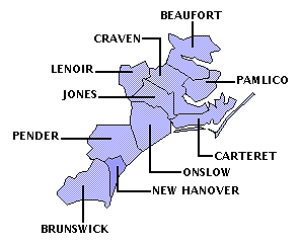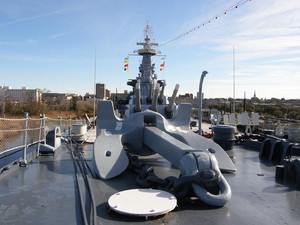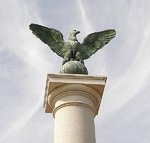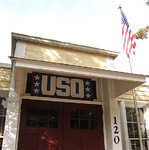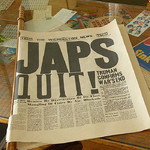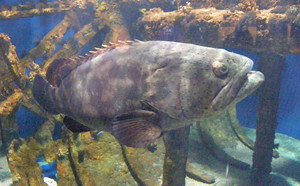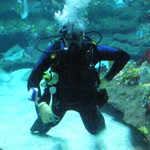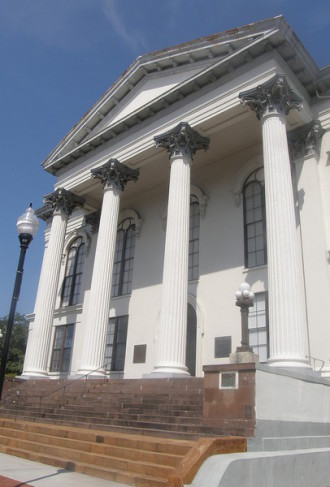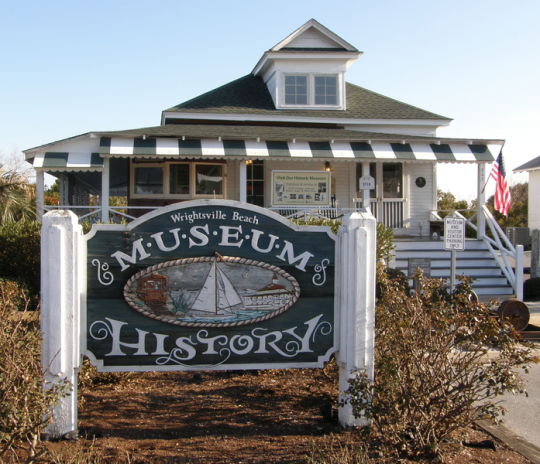NEW HANOVER COUNTY
Scroll down this page or click on specific site name to view features on the following New Hanover County attractions/points of interest:
Airlie Gardens, Battleship North Carolina Memorial, Bellamy Mansion, Burgwin-Wright House, Cape Fear Museum of History and Science, Cape Fear Serpentarium, Carolina Beach State Park, Fort Fisher State Historic Site, Fort Fisher State Recreation Area, Hannah Block Historic USO World War II Homefront Museum, Henrietta III, Latimer House, North Carolina Aquarium at Fort Fisher, Thalian Hall, Wilmington Railroad Museum, Wrightsville Beach Museum
Fast facts about New Hanover County:
Created in 1729, the county is named in honor of King George I of the House of Hanover.
The county seat is Wilmington, named for Spencer Compton, earl of Wilmington. Other communities include Castle Hayne, Carolina Beach, Kure Beach, and Wrightsville Beach.
New Hanover County’s land area is 198.93 square miles; the population in the 2010 census was 202,667.
It is worth noting that Fort Fisher was the target of the largest naval bombardment in history prior to World War II. During the Second World War, hundreds of liberty ships were built in Wilmington; the first to be launched, on December 6, 1941, was named the Zebulon Vance.
Wilmington
Be prepared to take lots of pictures when visiting Wilmington’s famous Airlie Gardens. There’s a modest admission fee, but these gardens are well worth the price. The landscaping is so well done that even folks who wouldn’t normally get excited at the prospect of visiting a garden will likely find their visit here a pleasantly memorable experience. Self-guided tours begin at the modern Services Center, where visitors can get a sneak peek at what flowers are currently in bloom as well as a quick overview of the garden’s history. Airlie Gardens had its origins more than 100 years ago, when Sarah Jones first began transforming a portion of her estate grounds into a carefully landscaped garden for the enjoyment of her family and friends. Her efforts certainly benefited from the presence of centuries-old oak trees draped with Spanish moss.
One of the focal points of the gardens today is the famed Airlie Oak. More than 465 years old, it towers majestically over the shrubs and flowerbeds of Airlie Lawn. In 1948, the Corbett family acquired the property and shortly thereafter opened the gardens to the public at various times throughout the season, most notably during the spring azalea bloom. It soon became a tradition for the newly-crowned queen of Wilmington’s Azalea Festival to visit the famed Gardens. In 1999, New Hanover County purchased the 67-acre Gardens, since which time the Gardens have been preserved by the county for public use.
Shaded paths lead guests from one picturesque setting to another, each one so beautiful that it’s hard to pick a favorite. One such focal point is the Showcase Gardens, where local landscapers arrange flowers, paths, pools, and statuary to interpret a yearly theme. The centerpiece of this area is a fountain installed by the Corbett family. Another highlight is the Pergola, an Italianesque feature built of coquina. This area was among the first to be developed when Sarah Jones began the transformation process in the early 1900s. A fountain serves as the focal point for this setting, and steps fanning out in a semi-circle lead down into the lake. It’s a relaxing spot to sit and watch the swans and geese drift effortlessly across the water.
Another tranquil spot is the Mount Lebanon Chapel, a traditional wood-framed house of worship built in 1835. Very picturesque, it is a popular place for weddings and receptions. A considerably less-traditional structure is the bottle chapel, created in 2004 as the centerpiece for the Minnie Evans Sculpture Garden. Evans was not only the Airlie Gardens gatekeeper from 1949 until 1974, but she was also one of America’s most visionary artists. Today her paintings are displayed in galleries and museums around the world. In the Sculpture Garden, local artists have paid tribute to Evans by means of their own reinterpretations of her work. Hours are 9-5 Tuesday-Sunday from mid-March through late December, including all holidays. 910-798-7700
Wilmington
The USS North Carolina, berthed in Wilmington, is preserved as a memorial to World War II veterans. Nicknamed “The Showboat,” the mighty battleship is a major tourist attraction and thousands walk her deck annually. The keel of the U. S. S. North Carolina was laid October 27, 1937 at the New York Navy Yard in Brooklyn. Launched June 13, 1940 and commissioned April 9, 1941, she was the first capital ship to be built in the United States in over twenty years and the first of ten so-called fast battleships.
Upon her completion, the North Carolina was regarded as the greatest sea weapon in the world, boasting a top speed of 28 knots and armed with nine 16-inch/45-caliber guns on three turrets, twenty 5-inch/38-caliber guns, sixty 40mm/56-caliber guns, and forty-eight 20mm/70-caliber guns. Her crew included 144 commissioned officers and 2,195 enlisted men. The ship was still steaming the Atlantic when the Japanese delivered their crushing blow to Pearl Harbor December 7, 1941. It was not until July of the following year that the North Carolina arrived at Pearl, by which time the naval battles of Midway and Coral Sea had already been fought.
Once becoming a part of the Pacific fleet, however, the North Carolina participated in every major naval offensive thereafter, from Guadalcanal to Okinawa. The ship was awarded fifteen battle stars for her gallant service, which included downing 24 enemy planes and sinking one troop ship. Remarkably, her crew suffered only ten fatalities and sixty-seven wounded despite being in harm’s way throughout the war. Following the end of hostilities, the North Carolina served as a training vessel for midshipmen until June 1947, when the ship was decommissioned.
In 1958, when plans were announced calling for the mighty warship to be sold for scrap, a grassroots “Save Our Ship” campaign garnered state-wide support. Financed in part by $325,000 in nickels and dimes collected by 700,000 school children across the state, the project bore fruition when, on October 2, 1961, the venerable “Showboat” moored at Eagle Island, across the river from Wilmington. The memorial opened April 29, 1962. A similar fundraising effort in 1998 called “Operation Shipshape” helped provide money for much needed repair and maintenance. In fulfillment of its original intent, Battleship North Carolina is dedicated to the men and women of her state who defended their country during World War II. The Battleship Wardroom on the main deck displays the Roll of Honor, containing the names of more than 10,000 North Carolinians from all branches of the armed forces who died in service to their country during the global conflict.
Visitors can explore portions of nine decks. On the main deck, they can examine the ship’s armament, squeezing inside one of the turrets of the 16-inch guns or looking from behind the sites of the ship’s anti-aircraft guns. Displayed on the ship’s fantail is a Kingfisher float plane. During the war, theNorth Carolinacarried as many as four of these recon-naissance planes, which were launched by means of a catapult. Below deck, the memorial accurately depicts shipboard life as visitors are routed through the enlisted men’s berthing quarters, the mess hall and galley, sick bay, radio room, machine shop, and engine room. The ship’s superstructure includes the captain’s cabin, admiral’s cabin, bridge, chart house, and combat information center.
The USS North Carolina Battleship Memorial is open daily year-round, including all major holidays. Summer hours (May 16-September 15) are 8 AM to 8 PM. Winter hours (September 16-May 15) are 8-5. Admission charged. Tours are self-guided; allow 3-4 hours to visit all decks. A large gift shop and snack bar are located on the premises. Special events and living history programs are held frequently throughout the year. 910-251-0480
Wilmington
In a city sparkling with architectural gems, The Bellamy Mansion on the corner of Market and Fifth Streets shines as one of the Port City’s crown jewels. This beautiful home was built on the eve of the Civil War as the city residence for Dr. John D. Bellamy, his wife, and nine children. Local architect James F. Post designed the 22-room, 4-story mansion in 1859 and, with the assistance of young Connecticut draftsman Rufus Bunnell, supervised the actual construction of the home. Much of the workmanship was done by Bellamy’s slaves, some of whom were skilled carpenters, and by free black artisans. The house was completed in 1861, but the Bellamy family left their new home only a year later, threatened by both an epidemic of yellow fever and the likelihood of Union invasion. Federal troops did indeed occupy Wilmington, but not until March of 1865. Union General Joseph Hawley used the Bellamy house as his headquarters while in command of occupational forces and refused to vacate the home when the family returned to Wilmington. Dr. Bellamy personally visited President Andrew Johnson in Washington and received a pardon, and the residence was returned to the family in the summer of 1865. The home remained in the immediate Bellamy family until the death of Miss Ellen Bellamy, the last surviving child, in 1946. Two descendants acquired ownership in 1951, but the house stood largely dormant until 1972, by which time the once-elegant mansion had fallen into disrepair.
The house seemed doomed when, just scant weeks after being acquired for restoration by a newly-established, non-profit or-ganization, an arsonist’s fire gutted much of the interior. Although the structure was stabilized in the aftermath of the fire, it was not until 1989 that new efforts began to refurbish the mansion. Actual work began in 1992, and the house opened as a museum of history and design arts in the spring of 1994. Guided tours of the home begin in the newly-constructed visitor center, built to resemble the carriage house that stood at the rear of the property. Many bricks from the original carriage house were used in its construction. After a brief orientation video, guests are taken to the main house. Front and side porches supported by massive Corinthian columns give the house the appearance of being even larger than it actually is. Tours include the raised “daylight” basement, which features the kitchen, butler’s pantry, dining room, and children’s dining room; the main floor, consisting of one double parlor with pocket doors, a smaller family parlor, and library; the second floor, with four bedrooms; and the third floor, with four children’s bedroom. Guests are also invited to climb the steps to the belvedere and enjoy the view it offers of historic Wilmington. The original, two-story brick slave quarters still stand at the rear of the property, adjacent to the carriage house, and future plans call for this to be restored and opened to the public as well. Visitors may also enjoy the neatly landscaped gardens at the front and side of the Mansion at their leisure.
The Bellamy Mansion is open 10-5 Wednesday-Saturday and 1-5 Sunday. Admission charged. Combination tickets that include tours of two other Wilmington homes, the Burgwin-Wright House and the Latimer House, can also be purchased. The Bellamy Mansion is a stewardship property of Preservation North Carolina, and current membership in that non-profit organization includes free admission to this site. 910-251-3700.
Wilmington
The Burgwin-Wright House, in addition to the claim that it was used by General Lord Cornwallis as his headquarters during the Revolutionary War, is an architectural attraction in and of itself, one of the finest surviving examples of Georgian architecture from North Carolina’s colonial period. The Burgwin-Wright House, at the intersection of Third and Market Streets, was built in 1770 for shipping magnate and lawyer John Burgwin and his family. A jail had originally been constructed on the site, and the ballast stones used which comprised the walls of the jail provided the foundation for the magnificent two-story Georgian-style home. Burgwin’s affluence did not protect him from personal tragedy, however, and he lost his first wife, Margaret, about the time the house was completed. Treatment for a severe leg injury ultimately required Burgwin to return to England, his native homeland, in 1775, where he remained until after the war for independence. During his stay in England, he leased his home to Judge Joshua Wright. The unfortunate timing of events led to suspicions that Burgwin was a Loyalist and his property was seized by patriots. Upon his return to North Carolina in 1782, accompanied by his second wife, Burgwin successfully petitioned the State Assembly to have his property returned. Burgwin sold the home to Dr. Wright in 1797, and the house remained in the Wright family until 1869. Today it serves as headquarters for the North Carolina Society of Colonial Dames, which maintains the site as a house-museum.
Although not documented, local tradition holds that the Burgwin-Wright house was used as headquarters for General Charles Cornwallis during the British occupation of Wilmington in 1781. Considering the general’s penchant for occupying the finest homes available while in Camden, Charlotte, and Hillsborough, it seems likely he would have been attracted to the Burgwin home. Another popular story associated with the house is that a British officer stationed at the home first drew the attention and then won the affection of a daughter of Judge Wright – the suitor scribed his initials and hers into one of the home’s window panes, and they are still there today.
Set back on a slight rise facing Market Street, the home makes a commanding appearance with double piazzas at both the front and rear. The rooms all display finely-detailed woodwork and showcase authentic period furnishings. Those familiar with North Carolina’s colonial history will recognize among the items displayed a portrait of Royal Governor Arthur Dobbs hanging above the fireplace in one of the sitting rooms. Another attraction to the site is a three-tiered, intricately-landscaped garden, a horticulturist’s delight. The house is open 10-4, Tuesday-Saturday. Admission charged. Discounted combination tickets that include admission to two other Wilmington homes, the Bellamy Mansion and the Lattimore House, are available. Tours of the house are given on the hour, last about 45 minutes, and include all rooms on the first and second floor, the basement, the south wing, added in 1845, and the separate kitchen. Visitors may walk the grounds and gardens at their leisure.
Wilmington
The Cape Fear Museum of History and Science is just one among many of Wilmington’s cultural attractions and is well worth a visit. The Museum is not only among the best in the state, but in May, 2000, it received accreditation from the American Association of Museums, the profession’s highest honor. The origins of the Cape Fear Museum date back to 1898, when the United Daughters of the Confederacy first opened a “relic room.” According to an article in the Wilmington Morning Star, “a creditable museum of Confederate relics is what the ladies [of the UDC] are determined to establish.” In the decades since, the collection has grown to include over 40,000 artifacts, the Museum’s location has changed several times, and operational control has shifted to from the UDC to New Hanover County, but the desire to provide the public with a “creditable museum” remains unchanged. In 1960, what was then known as the New Hanover County Museum moved into what had originally served as the National Guard Armory on Market Street. Since then, considerable space has been added on, and the facility now includes two floors of both permanent and temporary exhibits.
On permanent display are three impressive scale models, de-picting the Wilmington water-front during the Civil War, the battle of Fort Fisher, and the ironclad gunboat CSS Raleigh. The first two models were done circa 1966-67 and were ori-ginally displayed at the Block-ade Runner Museum at Carolina Beach. The waterfront model is quite large and can be viewed from three sides. It depicts a typical day’s activity along Wilmington’s docks. The Fort Fisher diorama focuses on the Federal breakthrough on the stronghold’s western land face on January 15, 1865. While viewing this diorama, visitors can listen to a description of the battle narrated by veteran newsman Doug Mayes. Artifacts from the battle are also on display. The third model is that of the Confederate ironclad Raleigh. This ill-fated gunboat was involved in one indecisive battle off Fort Fisher before it ran aground and sank in the mouth of New Inlet in 1864.
Those familiar with the Lumina, the legendary pavilion which was once the crown jewel of Wrightsville Beach, will find several notable artifacts on display, including boards from the Lumina’s famous ballroom dance floor. Other mementos include trophies won and dancing shoes worn by some of the Lumina’s patrons. Sadly, the Lumina was torn down in the 1970s; had it survived just a few years longer, it is possible that the preservationist movement that took hold in the 1980s might have been able to save it. Other Museum exhibits spotlight Wilmington’s colonial and Revolutionary War periods, her importance to the region and state as a commercial and trading hub, and social changes impacting the city during the 20th century. Children will likely enjoy spending time in the Michael Jordan Discovery Gallery, one of the more recent additions to the Museum. It is a “hands-on” exhibit intended to help children learn about their environment. Adults might be interested in a display of Jordan’s personal mementos, including his first pay stub in 1980 from Whitey’s El-Berta Restaurant. Earning $3.10 an hour, Jordan’s take-home pay for 47 hours on the job was $119.76. The Museum is located on Market Street. Hours are 9-5 Monday-Saturday and 1-5 Sunday. Admission charged. 910-341-4350
Wilmington
Among Wilmington’s newest attractions is the Cape Fear Serpentarium, the largest reptile zoo in the state. This indoor park is home to snakes from around the world and exhibits some of nature’s most exotic species, including a few so rare they are not shown anywhere else. Reptilian residents include a 23-foot long, 250-lbs python and a 15-foot long King Cobra. These and other fascinating reptiles are exhibited in carefully-rendered simulations of their natural environments. Many of the world’s most dangerous snakes are showcased here, and the Serpentarium has an amusing way of indicating how lethal they are on a scale of 1-to-5; instead of a number, however, the display window shows skulls. Many of the Serpentarium’s specimens earn 3, 4, or even 5 skulls! Whether you love snakes or loathe them, the Serpentarium lets you take a reptile safari right in the heart of downtown Wilmington. Cape Fear Serpentarium hours are 11-5 weekdays, 11-6 Saturday and Sunday. Admission charged. 910-762-1669
Carolina Beach
Carolina Beach State Park isn’t exactly what the name might suggest. Although located along North Carolina’s southern coastline, the park faces the Cape Fear River rather than the Atlantic Ocean, there is no beach, and swimming is strictly prohibited. Instead, the Park offers a marina, campsites, picnic facilities, and a variety of hiking trails. Created in 1969 as a means of preserving and protecting the rare environment along the Intracoastal Waterway, Carolina Beach State Park occupies 761 acres on a triangle of land called Pleasure Island. The land was once a part of the peninsula which lies between the Cape Fear River and the Atlantic Ocean. It became an island in 1930, when dredging operations at Snow’s Cut connected Cape Fear with Masonboro Sound, thus creating an inland passage for boat traffic along the Atlantic coast. The marina has two launching ramps and more than 40 boat slips. Fuel, snacks, and restrooms are available in the marina building. Showers are also provided for slip renters. The marina is located where Snow’s Cut meets the Cape Fear, so boaters have immediate access to the fresh waters of the river and are only a few minutes away from the estuarine waters of Masonboro Sound and the salt waters of the Atlantic. Fishing is permitted from the river bank or the wheelchair-accessible fishing deck. An N. C. Coastal Recreational Fishing License is required to fish in the park. Flounder and striped bass are two of the more common catches.
A family campground is situated under the shade of pine and oak trees near Snow’s Cut. 83 campsites are equipped with a picnic table and grill. Sites are available for a small fee on a first-come basis, and restrooms with hot showers are located nearby. For visitors not camping out, a picnic area between the marina and campground, and convenient to parking and restrooms, offers a scenic view of Snow’s Cut. If you’re not boating, fishing, or picnicking, there are six walking trails, ranging from ¼ mile to 3 miles. All are rated easy. The rare Venus fly trap is one of the plants seen along the edges of the pocosins and gives its name to one of the park trails; shorebirds and fiddler crabs are readily seen along the Sugarloaf Trail; and Snow’s Cut Trail travels through a stand of longleaf pine and live oaks. Wherever you are within the park, it’s not uncommon to spot white-tailed deer, raccoons, opossums, and, yes, an occasional snake. Every so often, an alligator meanders into the marina. The visitor center, completed in 2001, has environmental education exhibits relating to the plant life found within the park.
Trivia: Within the park’s boundaries is Sugarloaf, a 50-foot sand dune along the bank of the Cape Fear. Those familiar with nearby Fort Fisher might recognize the name. Sugarloaf not only served as a natural landmark for river pilots, but was also an observation post and part of the Confederate defense of Wilmington during the battle for Fort Fisher. From Wilmington, take US 421 South to Carolina Beach. After crossing Snow’s Cut Bridge over the Intracoastal Waterway, turn right at the second light onto Dow Road and follow the signs to the park entrance. Park hours are 8 AM-10 PM from May through August, shorter hours out of season. Visitor center hours are 8-5 daily. Visitors are advised to bring insect repellent during the warmer months. 910-458-8206
South of Kure Beach
Fort Fisher State Historic Site, at the mouth of the Cape Fear River, preserves the remains of the Confederacy’s last major stronghold. During the Civil War, Fort Fisher was the lynchpin in a series of fortifications along the lower Cape Fear intended to protect the important Confederate seaport of Wilmington. Construction of the fort began in 1861, and the massive earthwork fort was continuously improved upon and strengthened over the next three years under the able command of Colonel William Lamb. Shaped like an inverted ‘L,’ the fort’s landface stretched a half-mile across the southernmost tip of the peninsula that separated the Cape Fear River from the Atlantic Ocean. Cannons placed here protected the fort against the possibility of an assault by land. The seaface stretched nearly a mile in length, and batteries of long-range guns mounted here forced Federal warships to remain at a safe distance, giving swift blockade runners the opportunity to slip into the protected waters of the Cape Fear. By 1864, the fortifications had become so strong that Fort Fisher was referred to as the “Gibraltar of the South.”
The veracity of this claim went untested until the closing months of the rebellion. By winter, 1864, Wilmington was the last major seaport still open to the Confederacy. Determined to close this vital supply line, the U. S. Navy gathered the largest fleet of warships ever assembled to that point in time. During a two-day assault December 24 and 25, 1864, Federal ships pounded Fort Fisher with thousands of shells. The barrage claimed some Confederate casualties and destroyed a number of batteries, but Fort Fisher still stood. A planned ground assault by Union troops was aborted, and the fort’s defenders were given a brief respite.
In mid-January, 1865, however, the Navy renewed its bombardment. On January 13, Federal
warships began three days of shelling, which further reduced the effectiveness of the fort’s seaface guns but still failed to damage the fort’s defensive integrity. This time, however, a
two-pronged attack by land successfully breached the defenses along the western edge of the landface. Fierce hand-to-hand combat raged for several hours, but superior numbers gradually resulted in a
Union victory. Other Cape Fear fortifications offered little resistance, and Wilmington fell within a month.
Little of Fort Fisher’s original earthen fortifications remain today. What naval bombardment could not accomplish, time and neglect did. Over the years, storms and waves washed away much of the fort; a World War II military base took away more; a highway traversing the heart of the compound wiped out even more. Still, the Civil War’s centennial brought about conservation efforts that led to the preservation of the surviving landface earthworks. Today, it is the most frequently visited of North Carolina’s state maintained historic sites. The visitor center, refurbished in 2000, offers a video program and museum and staff members give tours of the earthworks. A reconstruction of Shepherd’s Battery gives visitors a representative view of what the fort’s gun emplacements looked like before the Union assault. Each January, on the weekend closest to the anniversary of the battle, the site hosts a Civil War encampment.
Admission to Fort Fisher is free. Normal hours are 9:00-5:00 Monday-Saturday and 1:00-5:00 Sunday from April through October. Other months, the hours are 10:00-4:00 Tuesday-Saturday and 1:00-4:00 Sunday.
South of Kure Beach
If an uncrowded, unspoiled beach is what you’re after, you need look no further than Fort Fisher State Recreation Area. Located at the southern tip of Pleasure Island, this state-maintained park offers seven miles of pristine, undeveloped shore line. It’s the perfect spot for beachcombing, sunbathing, or swimming. From Memorial Day through Labor Day, a lifeguard is on duty at the designated swimming area near the parking area. A concession stand is open during the summer season as well. A ranger station is located at the parking area, along with a ranger station and small nature center and modern restrooms. Hikers will enjoy the short nature trail that leads though a salt marsh to an observation area overlooking the Cape Fear River. Anglers can expect to hook bluefish, puppy drum, and Virginia mullet.
Fort Fisher provides important nesting areas for two endangered species. One is the piping plover, a small bird that resembles a sandpiper. The other is the loggerhead sea turtle. The sandy beach at Fort Fisher offers good nesting habitat for these turtles, and their nests are carefully marked off to prevent their being disturbed. Visitors are cautioned to leave such nests untouched.
World War II Homefront Museum
Wilmington
The Hannah Block Historic USO Building, listed on the National Register of Historic Places, is one of the few United Service Organization buildings from the World War II era still surviving. Although it now serves as the Community Arts Center, hosting meetings, wedding receptions, art shows, and other events, the lobby of the building still closely resembles its appearance circa 1943. With the possibility of war approaching, President Franklin Roosevelt formed the USO, thus facilitating many diverse organizations to come together for a common purpose. These groups included The Salvation Army, the YMCA and YWCA, the National Catholic Community Services, and the National Jewish Welfare Board.
The USO facility at the corner of Second and Orange Streets served white servicemen only; a separate facility located a few blocks away, and which no longer stands, provided for the needs of black servicemen. Both facilities opened in the fateful month of December, 1941, and soon became the off-duty destinations for men serving at the Army anti-aircraft base at Camp Davis in Holly Ridge; the Marine amphibious facility at Camp Lejeune in Jacksonville; the Army airborne center at Fort Bragg in Fayetteville; and such war-related industries as the North Carolina Shipbuilding Company in Wilmington, building the famed “Liberty Ships,” and the Ethyl-Dow Chemical plant in Kure Beach.
The USO remained open 24 hours a day, 7 days a week, throughout the war, and served an average of 94,500 guests each month. By the time the facility closed in June, 1946, nearly 2.4 million visitors had passed through its doors. Along with coffee and doughnuts, the center offered servicemen entertainment, relaxation, accommodations, and assistance. The “heart and soul” of the USO, of course, were the volunteers, best personified by the Junior Hostesses, affectionately known as the “Liberty Belles” and, later, as the “Victory Belles.” 18-to-25 years of age, these engaging, vivacious women conversed with the servicemen, provided dance partners, prepared refreshments, helped with decorations, sewed buttons and insignia onto uniforms, and visited convalescing servicemen in the hospital.
The building was purchased by the city in 1946; in 1948, it hosted the opening ceremony for the first Azalea Festival and has been used for a wide variety of community functions ever since. In 2006, the building was named in honor of Hannah Block, recognized locally as “Mrs. World War II Wilmington.” The lobby piano she played for servicemen is one of many artifacts on display. A continuously-running video program gives a brief history of the building. It opens to the strains of Glenn Miller’s “String of Pearls,” and the music sets the right background for perusing the lobby exhibits. There are reproductions of period newspapers; ration books and stamps; uniforms; propaganda posters and literature; and models of planes and ships. Among the latter is a model of the Liberty Ship SS Virginia Dare. There are photos of the launching of Wilmington’s first Liberty Ship, the SS Zebulon Vance, which, ironically, was launched Saturday, December 6, 1941. At its peak in 1943, the Wilmington shipyard employed 50,000 workers, including many women. By war’s end, the yard had built 243 Liberty Ships, an average of better than one ship every week!
A visit to this USO facility is the perfect compliment to a tour of the Battleship North Carolina Memorial, also located in Wilmington.
Wilmington
"Welcome aboard!" Day or night, a journey up and down the Cape Fear River on board the Henrietta III is always a treat. 90-minute narrated sightseeing trips, lunch cruises, and sunset dinner cruises are offered April through December. Moonlight cruises likewise fit just about every schedule. North Carolina’s largest riverboat has heated and air conditioned salons and outdoor observation decks, so weather seldom interferes with enjoying a cruise along Wilmington’s historic waterfront. 910-343-1611
Wilmington
The Latimer House dates to 1852 and reflects the Victorian “Italianate” style popular at the time. It has the distinction of being the first home in Wilmington to be wired for electric lights. Built for prosperous businessman Zebulon Latimer and his family, it is brimming with original period furnishings and family heirlooms. One especially memorable piece is the huge Dresden urn displayed in the double parlor. The house-museum is currently home to the Lower Cape Fear Historical Society. The Latimer House is open 10-3:30 Monday-Friday and 12-5 Saturday. Admission charged. A combination ticket which includes admission to the Bellamy Mansion and the Burgwin-Wright House is also available.
South of Kure Beach
The North Carolina Aquarium at Fort Fisher is located on the southern tip of Pleasure Island, on the eastern side of the mouth of the Cape Fear River. While most states are fortunate to have one aquarium to educate and entertain its residents, North Carolina actually has three recently-renovated, greatly expanded, and much improved branch aquariums from which to choose. Individually, none is as grand or spacious as the Georgia Aquarium in Atlanta, the South Carolina Aquarium in Charleston, or the Tennessee Aquarium in Chattanooga. Collectively, however, the trio of Tar Heel aquariums provides visitors with a balanced look at aquatic life across the state. The Fort Fisher branch in particular benefits from the outdoor opportunities offered at the adjacent Fort Fisher State Recreation Area. Each of the three NC Aquariums focuses on a different aspect of aquatic life. "Waters of the Cape Fear" is the theme of the Fort Fisher facility.
Along with the aquarium’s main tank, smaller tanks allow for up-close viewings of such creatures as cephalopods, cuttlefish, lionfish, and spiny lobsters. In the Cape Fear Conservatory section, be prepared to stare eyeball to eyeball with alligators! Another featured exhibit incorporates a half-scale facsimile of a section of the blockade runner Condor, which ran around on her maiden voyage in October, 1864. The wreckage lies in 25 feet of water about one mile from where the aquarium is located. Along with
the provisions on board the Condor, the Confederacy lost one of its most notable spies, Rose O’Neal Greenhow. The story goes that the female spy was carrying not only government secrets, but 400 British gold sovereigns. Not willing to leave this treasure behind, Greenhow attempted to carry it with her as she swam for shore. Burdened by the weight of the gold, however, she was carried under only a few yards from safety. Aquarium hours are 9-5 daily, year-round. Closed Thanksgiving, Christmas, and New Year's Day. Admission charged. 866-301-3476
Wilmington
One of Wilmington’s oldest city landmarks is Thalian Hall. The Italianate-style building was constructed in 1858, and the theater has been in continuous use for more than 150 years. Performances at the Hall have ranged from plays, concerts, and recitals to lectures, political events, and social functions, and the list of performers who have appeared on its stage include the likes of John Phillip Sousa, Buffalo Bill Cody, Oscar Wilde, and Tom Thumb. The building features three performance venues: the Studio Theatre, the grand ballroom, and the historic 1858 Main Stage. Operating year-round, Thalian Hall offers a variety of theatrical productions. Thalian Hall is located at 310 Chestnut Street. 910-632-2285
Wilmington
The Wilmington Railroad Museum, housed in the former offices of the Atlantic Coast Line Rail Road, sheds light on the Port City’s railroad heritage. Rail transportation was Wilmington’s chief industry for more than a century, and the Wilmington and Weldon Railroad, when completed in 1840, covered 161 miles and was the longest rail line in the world. Visitors to the Museum can see railroading memorabilia, enjoy model train displays, climb aboard a steam locomotive, and explore a bright red caboose. There is also a “Hands On” Children’s Corner. The Railroad Museum is located at 505 Nutt Street, near the Cape Fear River and adjacent to the Wilmington Convention Center. Hours are 10-5 Monday-Saturday and 1-5 Sunday. Closed Mondays from November through March. Admission charged.
Wrightsville Beach
In 1909, it was the Myers Cottage, one of about twenty such small houses built by the Suburban Developing Company, a subsidiary of the Tide Water Power Company. Today, it is home to the Wrightsville Beach Museum of History. Visitors who kick the sand off their feet long enough to step inside will likely get a kick at what they find. In just a tiny space, the Museum does a nice job of bring the history of this resort community to life. The cottage was built with trolley tracks only a few feet off its spacious front porch and the Atlantic Ocean just a few feet off the back. Until the late 1930s and early 1940s, Wrightsville was almost exclusively a summer resort, and the trolley line was its main artery. It’s appropriate, then, that a portion of what is thought to be the last trolley to run from Wilmington to Wrightsville Beach is now displayed on the cottage’s side porch! The Museum features a large model of the resort town in its hey-day, including the Seashore and Oceanic hotels and the long-gone but fondly remembered Lumina Pavilion. This beachside gem had all the amenities: eating pavilions, bowling alley, dance hall, bath house, miniature golf, a playground in the water, even a theater screen on the beach! The Museum is located at 303 West Salisbury Street. Hours are 10-4 Tuesday-Friday, 12-5 Saturday, and 1-5 Sunday. Admission is free. 910-256-2569
New Hanover County is bordered by BRUNSWICK and PENDER counties.
Return to REGION THREE HOME PAGE.
Return to GEOGRAPHIC REGIONS HOME PAGE.

